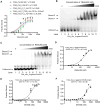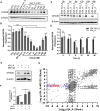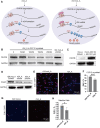RNA G-quadruplex structure-based PROTACs for targeted DHX36 protein degradation and gene activity modulation in mammalian cells
- PMID: 39883012
- PMCID: PMC11780864
- DOI: 10.1093/nar/gkaf039
RNA G-quadruplex structure-based PROTACs for targeted DHX36 protein degradation and gene activity modulation in mammalian cells
Abstract
RNA G-quadruplexes (rG4s) are non-canonical secondary nucleic acid structures found in the transcriptome. They play crucial roles in gene regulation by interacting with G4-binding proteins (G4BPs) in cells. rG4-G4BP complexes have been associated with human diseases, making them important targets for drug development. Generating innovative tools to disrupt rG4-G4BP interactions will provide a unique opportunity to explore new biological mechanisms and potentially treat related diseases. Here, we have rationally designed and developed a series of rG4-based proteolytic targeting chimeras (rG4-PROTACs) aimed at degrading G4BPs, such as DHX36, a specific G4BP that regulates gene expression by binding to and unraveling rG4 structures in messenger RNAs (mRNAs). Our comprehensive data and systematic analysis reveals that rG4-PROTACs predominantly and selectively degrade DHX36 through a proteosome-dependent mechanism, which promotes the formation of the rG4 structure in mRNA, leading to the translation inhibition of rG4-containing transcripts. Notably, rG4-PROTACs inhibit rG4-mediated APP protein expression, and impact the proliferative capacity of skeletal muscle stem cells by negatively regulating Gnai2 protein expression. In summary, rG4-PROTACs provide a new avenue to understand rG4-G4BP interactions and the biological implications of dysregulated G4BPs, promoting the development of PROTACs technology based on the non-canonical structure of nucleic acids.
© The Author(s) 2025. Published by Oxford University Press on behalf of Nucleic Acids Research.
Conflict of interest statement
The authors declare that they have no competing financial interest.
Figures







Similar articles
-
RNA G-quadruplexes at upstream open reading frames cause DHX36- and DHX9-dependent translation of human mRNAs.Genome Biol. 2018 Dec 27;19(1):229. doi: 10.1186/s13059-018-1602-2. Genome Biol. 2018. PMID: 30591072 Free PMC article.
-
Translational control by DHX36 binding to 5'UTR G-quadruplex is essential for muscle stem-cell regenerative functions.Nat Commun. 2021 Aug 19;12(1):5043. doi: 10.1038/s41467-021-25170-w. Nat Commun. 2021. PMID: 34413292 Free PMC article.
-
Selective recognition of RNA G-quadruplex in vitro and in cells by L-aptamer-D-oligonucleotide conjugate.Nucleic Acids Res. 2024 Dec 11;52(22):13544-13560. doi: 10.1093/nar/gkae1034. Nucleic Acids Res. 2024. PMID: 39558155 Free PMC article.
-
Exploring the biological roles of DHX36, a DNA/RNA G-quadruplex helicase, highlights functions in male infertility: A comprehensive review.Int J Biol Macromol. 2024 May;268(Pt 2):131811. doi: 10.1016/j.ijbiomac.2024.131811. Epub 2024 Apr 25. Int J Biol Macromol. 2024. PMID: 38677694 Review.
-
G-Quadruplexes and the DNA/RNA helicase DHX36 in health, disease, and aging.Aging (Albany NY). 2021 Dec 4;13(23):25578-25587. doi: 10.18632/aging.203738. Epub 2021 Dec 4. Aging (Albany NY). 2021. PMID: 34862880 Free PMC article. Review.
References
MeSH terms
Substances
Grants and funding
- 32471343/National Natural Science Foundation of China
- RFS2425-1S02/Research Grants Council (RGC) of the Hong Kong Special Administrative Region
- 9509003/Croucher Foundation Project
- SCRF/0037/State Key Laboratory of Marine Pollution Seed Collaborative Research Fund
- 22377153/Natural Science Foundation of China
LinkOut - more resources
Full Text Sources
Miscellaneous

